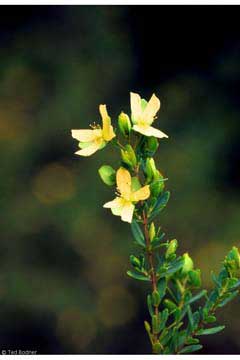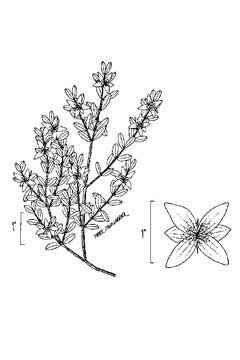 |
|
Ted Bodner @ USDA-NRCS PLANTS Database / Miller, J.H. and K.V. Miller. 2005. Forest plants of the southeast and their wildlife uses. University of Georgia Press, Athens. |
 |
| USDA-NRCS PLANTS Database / USDA NRCS. Wetland flora: Field office illustrated guide to plant species. USDA Natural Resources Conservation Service. |
Translate this page:
Summary
Physical Characteristics

 Hypericum hypericoides is a deciduous Shrub growing to 1.2 m (4ft).
Hypericum hypericoides is a deciduous Shrub growing to 1.2 m (4ft).
See above for USDA hardiness. It is hardy to UK zone 6. It is in flower from July to September. The species is hermaphrodite (has both male and female organs) and is pollinated by Insects. The plant is self-fertile.
Suitable for: light (sandy) and medium (loamy) soils and prefers well-drained soil. Suitable pH: mildly acid, neutral and basic (mildly alkaline) soils. It can grow in semi-shade (light woodland) or no shade. It prefers dry or moist soil.
UK Hardiness Map
US Hardiness Map
Synonyms
Ascyrum hypericoides.
Plant Habitats
Woodland Garden Sunny Edge;
Edible Uses
References More on Edible Uses
Medicinal Uses
Plants For A Future can not take any responsibility for any adverse effects from the use of plants. Always seek advice from a professional before using a plant medicinally.
Antidote Kidney Lithontripic
Lithontripic[61]. The root was chewed as an antidote to rattlesnake bites[207, 222]. A tea made from the roots is used in the treatment of colic, fevers, pain, diarrhoea etc[222]. It is applied externally to ulcerated breasts[222]. A tea made from the leaves is used in the treatment of kidney and bladder ailments, skin problems and children's diarrhoea[61, 222]. A milky substance obtained from the plant has been rubbed on sores[257].
References More on Medicinal Uses
The Bookshop: Edible Plant Books
Our Latest books on Perennial Plants For Food Forests and Permaculture Gardens in paperback or digital formats.

Edible Tropical Plants
Food Forest Plants for Hotter Conditions: 250+ Plants For Tropical Food Forests & Permaculture Gardens.
More

Edible Temperate Plants
Plants for Your Food Forest: 500 Plants for Temperate Food Forests & Permaculture Gardens.
More

More Books
PFAF have eight books available in paperback and digital formats. Browse the shop for more information.
Shop Now
Other Uses
References More on Other Uses
Cultivation details
Easily grown in any reasonably good well-drained but moisture retentive soil[1]. Succeeds in sun or semi-shade but flowers better in a sunny position[1]. Prefers a light loamy soil[11]. One report says that the plant requires frame protection in the winter[1] whilst another says that plants are hardy but short-lived at Kew[11]. It possibly suffers more from wet soils than from the cold, see the plant's native habitat above. Plants in this genus are notably resistant to honey fungus[200].
References Carbon Farming Information and Carbon Sequestration Information
Temperature Converter
Type a value in the Celsius field to convert the value to Fahrenheit:
Fahrenheit:
The PFAF Bookshop
Plants For A Future have a number of books available in paperback and digital form. Book titles include Edible Plants, Edible Perennials, Edible Trees,Edible Shrubs, Woodland Gardening, and Temperate Food Forest Plants. Our new book is Food Forest Plants For Hotter Conditions (Tropical and Sub-Tropical).
Shop Now
Plant Propagation
Seed - sow spring in a greenhouse and only just cover the seed. Germination usually takes place within 1 - 3 months at 10°c. When they are large enough to handle, prick the seedlings out into individual pots and grow them on in the greenhouse for their first winter. Plant them out into their permanent positions in late spring or early summer, after the last expected frosts. Cuttings of half-ripe wood 10 - 12 cm with a heel, July/August in a frame. Plant out in the following spring[200]. Cuttings of mature wood, 12 - 17cm with a heel, October/November in a sheltered position outdoors. Plants root by the spring. Good percentage[78]. Division in spring as new growth commences[78]. Very easy, larger clumps can be replanted direct into their permanent positions, though it is best to pot up smaller clumps and grow them on in a cold frame until they are rooting well. Plant them out in the spring.
Other Names
If available other names are mentioned here
Native Range
NORTHERN AMERICA: United States (Indiana (south), Massachusetts, New Jersey, New York, Ohio (south), Pennsylvania (south), West Virginia, Illinois (south), Kansas (southeast), Missouri (south), Oklahoma, Alabama, Arkansas, Delaware, Florida, Georgia, Kentucky, Louisiana, Maryland, Mississippi, North Carolina, South Carolina, Tennessee, Virginia, District of Columbia, Texas), Mexico (Nuevo León, Tamaulipas, Chiapas, Hidalgo, Michoacán de Ocampo, Oaxaca, Puebla, Veracruz de Ignacio de la Llave) SOUTHERN AMERICA: Bahamas, Bermuda, Cuba, Dominican Republic, Haiti, Jamaica, United States (Puerto Rico), Guatemala, Honduras
Weed Potential
Right plant wrong place. We are currently updating this section.
Please note that a plant may be invasive in one area but may not in your area so it's worth checking.
Conservation Status
IUCN Red List of Threatened Plants Status :

Growth: S = slow M = medium F = fast. Soil: L = light (sandy) M = medium H = heavy (clay). pH: A = acid N = neutral B = basic (alkaline). Shade: F = full shade S = semi-shade N = no shade. Moisture: D = dry M = Moist We = wet Wa = water.
Now available:
Food Forest Plants for Mediterranean Conditions
350+ Perennial Plants For Mediterranean and Drier Food Forests and Permaculture Gardens.
[Paperback and eBook]
This is the third in Plants For A Future's series of plant guides for food forests tailored to
specific climate zones. Following volumes on temperate and tropical ecosystems, this book focuses
on species suited to Mediterranean conditions—regions with hot, dry summers and cool, wet winters,
often facing the added challenge of climate change.
Read More
Expert comment
Author
(L.)Crantz.
Botanical References
1143200
Links / References
For a list of references used on this page please go here
Readers comment
© 2010, Plants For A Future. Plants For A Future is a charitable company limited by guarantee, registered in England and Wales. Charity No. 1057719, Company No. 3204567.